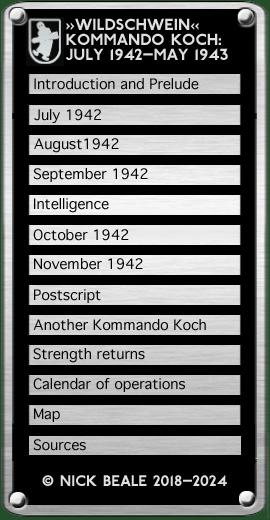|
Four days later, G/C Colin Cadell responded: There are at least three kinds of special aircraft in Middle East. First there are Ju 88 of 3.(F)/123 fitted with Lichtenstein, the German-built equivalent of ASV Second is an He 111 of II./KG 100 which is fitted with a captured ASV of our own. Third are the Wildschwein Ju 52 and He 111, each fitted with two jammers: one on 176 and the other presumably on 214 megacycles, for jamming our ASV frequencies. They are monitored from a station on Crete which probably also watches our other RDF frequencies in the eastern Mediterranean. If the RAF had built up quite a good picture in the space of three weeks, the next part of Cadell’s answer would become obsolete within hours of his message being sent: … It is odd that no ASV jamming has been noticed since Germans think they have had considerable success, including making our aircraft change frequency … Should be quite possible to home on ASV jammer and work is in progress here.
On the 24th Gen. Hans-Ferdinand Geisler had been transferred from command of Fliegerkorps X to special duties at the Reich Air Ministry (RLM) and was replaced by Gen. Otto Hoffmann von Waldau, hitherto Fliegerführer Afrika. That night one of the Kommando’s He 111 jammed “several British aircraft” while patrolling the sea area west of Greece, before landing at Lecce at 0220. The following afternoon at 1657, GJ+JH took off on a sortie that was to end with a landing at Catania at 0105. The crew reported that they had picked up no “enemy apparatus” (ASV in other words) and that two of their Heinkel’s four jamming transmitters were out of action. Fliegerkorps II recorded this flight as: “KG 54, operation by Special He 111 against ASV-reconnaissance aircraft, on baseline [50 km W Zakynthos – 100 km S Santa Maria di Leuca], beginning around 2200 hrs.[GMT+2] until limit of fuel”. A thorough investigation is being made but at [the] moment evidence of ASV jamming is nil. RAF Middle East, 27 August 1942 The RAF was not alone investigating radar performance that day. Spitfires from Malta strafed airfields and a Freya installation on Sicily. If the this last attack was detected in time to alert the defences, the strikes against on Comiso and Gela were not. In consequence this “renewed” failure on the reporting services’ part was to be the subject of an inquiry by II. Fliegerkorps.
The night of the 26th/27th saw II. Fliegerkorps committing all the operationally ready crews of KG 54, KG 77 and 1.(F)/122 to a raid on Luqa’s dispersals. Photo-reconnaissance evaluations were to be provided to units in good time and loads were to be predominantly AB 23 canisters and fragmentation bombs. Some HE should also be used against the runways and limited numbers of delayed-action bombs with fuses set for as late of 0700 on the 27th. The Regia Aeronautica would go in first, at 2345 [GMT+2] with the Luftwaffe following at 0030. The German attack was to be concentrated into a 5-minute span. Crews of aircraft with Caruso were told that it was necessary to switch the set off temporarily.
In planning convoy escorts for 27 August, Kesselring’s staff called for 10 Bf 110 of Kdo. Herling (an ad hoc daylight escort force) to be ready to intercept approaching ASV searchers if alerted by the Cretan WIM stations. There was to be a continuous dawn–dusk jamming operation “by Wildschwein which by then will have again been brought up” against ASV aircraft from Egypt and in the event one He 111 carried this out from 1600, apparently landing at Kalamaki shortly after midnight. There should have been three jammers but “after changing engines [one] had a failure of its signals apparatus” and another on its way from Germany force-landed in Belgrade with engine trouble. On the vessels reported sunk or damaged on 27/8, considerable quantities of German supply cargoes were destroyed. The casualty list of the last two days is deplorably high. The enemy’s attacking energy—both the submarines’ and the air forces’—has in no way diminished … Seekriegsleitung, 28 August 1942 The raid by bombers of Fl.Kps. X against Alexandria on the night of 28/29 August was described by RAF Signals Intelligence as the “prelude to the renewal of hostilities in the Western Desert and … clearly the most important of the month.” The Korps was reinforced by aircraft which flew in from Sicily that afternoon and returned to Catania the following day. What the British later described as an “all-out night raid” was backed up by a concerted electronic effort: Operation by WIM 9, El Daba [El Dabaa, Egypt]: 4 jamming transmitters against Bordsuchgerät [airborne search radar]. 2 WIM-He 111 against enemy ground FuMG [radar] System 2000. On frequencies so far observed, the presence of an apparatus has not been established by WIM 6, Crete East. 9. /W/T Listening Coy. 40 [9. (Funkhorch)/Luftnachrichtenregiment 40] report to their surprise no R/T traffic intercepted from ultra-short wave (fighter R/T). Units landing after one operation report nothing observed in target area apart from one night fighter and one burst of MG fire. continued on next page …
|
|||||

